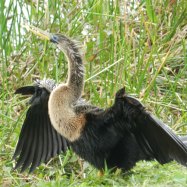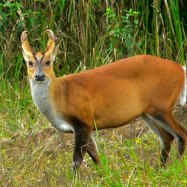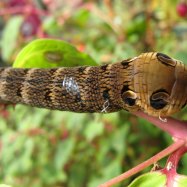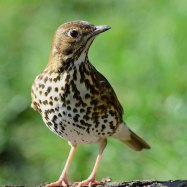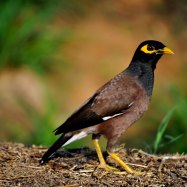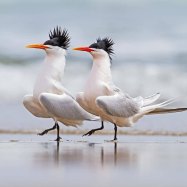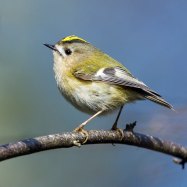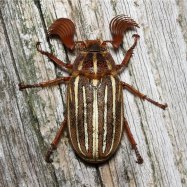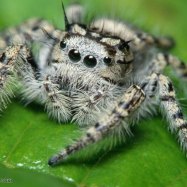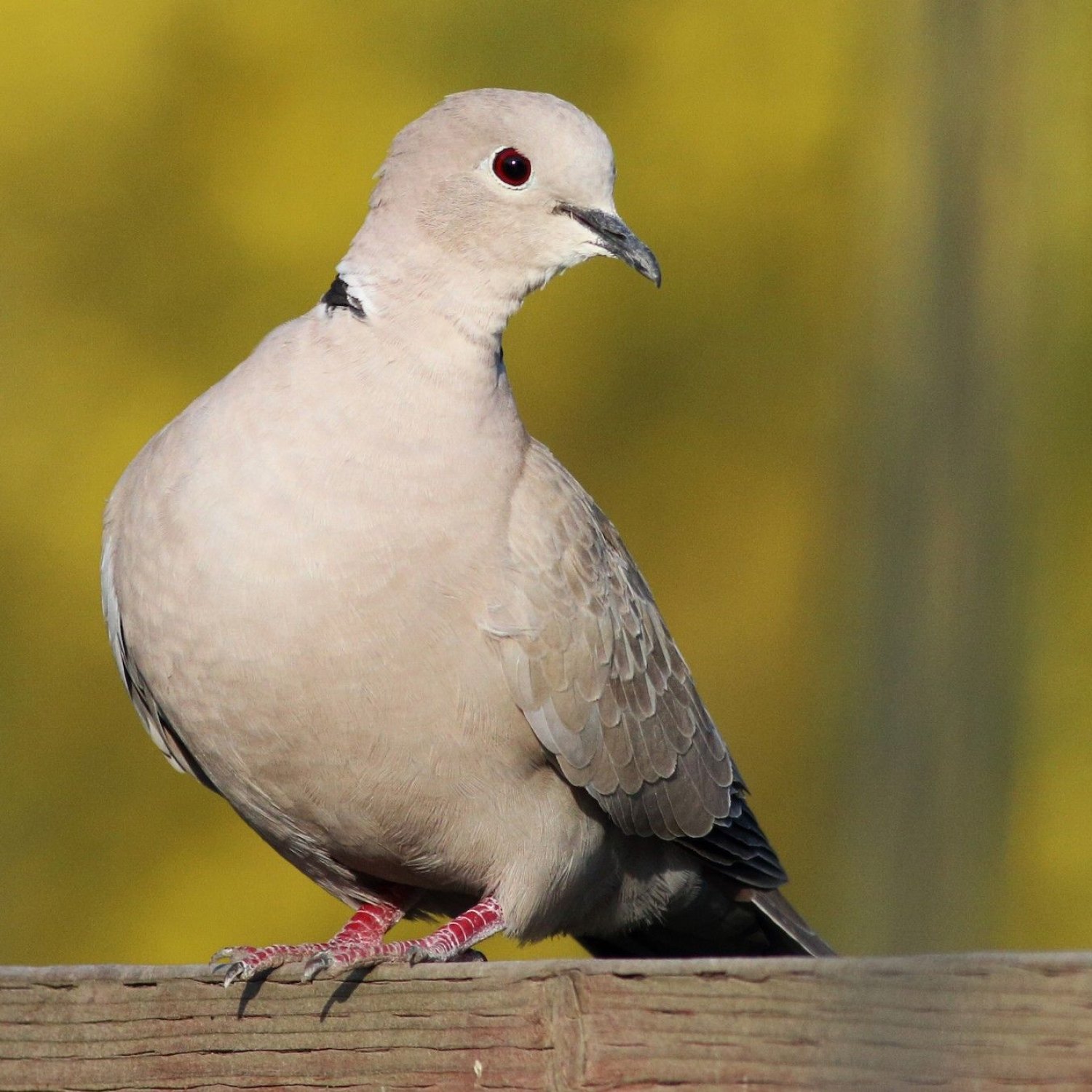
Eurasian Collared Dove
32-35 cm
The Eurasian Collared Dove, also known as just Collared Dove, is a medium-sized bird with a plump shape and a long tail. It can reach a length of 32-35 cm and can be found in a wide range across various countries. Belonging to the Columbidae family, this bird is a common sight in parks, gardens, and cities. Have you spotted one of these beautiful doves in your area? 🕊️ #EurasianCollaredDove #Birdwatching #NatureLover
Animal Details Summary:
Common Name: Eurasian Collared Dove
Kingdom: Animalia
Habitat: Urban and suburban areas, farmlands, open woodlands
The Story of the Dainty and Adaptable Eurasian Collared Dove
Have you ever heard the soft cooing sounds that fill the air in urban and suburban areas, farmlands, and open woodlands? Chances are, you have encountered the charming Eurasian collared dove (Streptopelia decaocto). This medium-sized bird, with its plump body and long tail, has adapted to various habitats and can be found in Europe, Asia, Africa, and even North America. Its distinctive coloration and unique features make it an interesting subject to study and observe. So, let's dive into the story of the dainty and adaptable Eurasian collared dove Eurasian Collared Dove.A Global Citizen
The Eurasian collared dove is truly a global citizen, with a wide range across various countries. It is believed to have originated from the country of Turkey, where it gets its scientific name, decaocto, from the Turkish word for "eighteen." This refers to the distinctive black half-collar on the back of its neck, which resembles the number 18 when viewed from a distance.In the early 1900s, this species began to spread out of its native range and quickly colonized parts of Europe, Asia, and Africa. Its adaptability and ability to thrive in various habitats allowed it to rapidly expand its range, reaching North America in the 1970s. Today, it is estimated that there are over 60 million Eurasian collared doves in North America alone.
A Familiar Sight and Sound
One of the reasons why the Eurasian collared dove is so beloved and well-known is because of its frequent presence in urban and suburban areas. Its natural habitats have been greatly altered by human development, and these birds have learned to adapt and even thrive in these areas.The cooing sounds of Eurasian collared doves can be heard throughout the day, creating a soothing and peaceful soundtrack to our daily lives Eurasian Jay. This is because they are most active during the day, unlike other dove species that are more active at dusk and dawn. Their gentle and calming coos are often used as background noise in movies and TV shows, adding to their familiar presence in our lives.
Beauty in Simplicity
The Eurasian collared dove may not possess the vibrant colors of some other bird species, but its understated beauty lies in its simplicity. Its coloration is predominantly pale gray, with darker gray wings and a lighter gray underside. The black half-collar on the back of its neck is a distinguishing feature that sets it apart from other dove species.Their plump body and long tail give them a cute and dainty appearance, making them a favorite among birdwatchers and nature enthusiasts. Whether they are perched on a tree branch or walking on the ground, they exude an air of calm and grace, making them a pleasure to observe.
Diet and Feeding Strategy
The Eurasian collared dove is considered a granivorous species, meaning it mainly feeds on grains and seeds. In urban areas, they can often be seen scavenging for food, feeding on seeds and grains dropped by other birds or humans. But they are also known to forage in farmlands and open woodlands for their preferred food sources, such as wheat, barley, and corn.Their feeding strategy is also quite interesting to observe. They tend to feed in small groups, taking turns to watch for potential predators while the others eat. This social behavior helps them stay safe while still being able to feed and also showcases their adaptability in utilizing resources efficiently.
Adaptability and Resilience
Speaking of adaptability, the Eurasian collared dove's ability to thrive in various habitats is truly remarkable. They are commonly found in urban and suburban areas, farmlands, and open woodlands, but they have also been observed in mountainous regions and deserts. This adaptability is key to their success in colonizing new territories and expanding their range.Furthermore, the Eurasian collared dove is known for its resilience and strong survival instinct. They have survived in the wild for over 13 years, and some have even been observed living for over 20 years. This is quite impressive for such a small bird and speaks to their remarkable adaptive abilities.
Impact on Ecosystems
As with any non-native species, there is always a concern about their impact on the ecosystems they invade. However, the Eurasian collared dove has not shown any significant negative effects on the environments in which they have colonized.Since they primarily feed on grains and seeds, they do not compete with native bird species for food sources. In fact, their adaptability has helped them fill a niche in environments that have been altered by human development. They have also been observed to occasionally prey on small insects, which can be beneficial in controlling pests in urban and agricultural areas.
Conservation Status
The Eurasian collared dove is currently classified as a species of "Least Concern" by the International Union for Conservation of Nature (IUCN). This means that their population is stable and not at immediate risk of extinction.However, there are some potential threats to their population, such as habitat loss and predation by domestic and feral cats. Human disturbance and climate change may also have an impact on their survival in the future. Therefore, continued monitoring and conservation efforts are necessary to ensure their population remains stable.
Bringing Joy to Our Lives
The Eurasian collared dove may not be the most colorful or most talked about bird species, but their presence in our lives brings a sense of comfort and joy. Their simple beauty, charming coos, and adaptability make them a beloved and familiar species in many countries.As we continue to alter and develop our environment, it is essential to appreciate and protect the wildlife that has learned to coexist with us. The Eurasian collared dove is a prime example of a species that has adapted and thrived, bringing a touch of nature into our bustling urban and suburban areas.
So, the next time you hear the soft cooing sounds echoing through the air, take a moment to appreciate the dainty and adaptable Eurasian collared dove, a true global citizen.

Eurasian Collared Dove
Animal Details Eurasian Collared Dove - Scientific Name: Streptopelia decaocto
- Category: Animals E
- Scientific Name: Streptopelia decaocto
- Common Name: Eurasian Collared Dove
- Kingdom: Animalia
- Phylum: Chordata
- Class: Aves
- Order: Columbiformes
- Family: Columbidae
- Habitat: Urban and suburban areas, farmlands, open woodlands
- Feeding Method: Granivorous
- Geographical Distribution: Europe, Asia, Africa, North America
- Country of Origin: Turkey
- Location: Wide range across various countries
- Animal Coloration: Pale gray, with a distinctive black half-collar on the back of the neck
- Body Shape: Medium-sized bird, plump shape, long tail
- Length: 32-35 cm
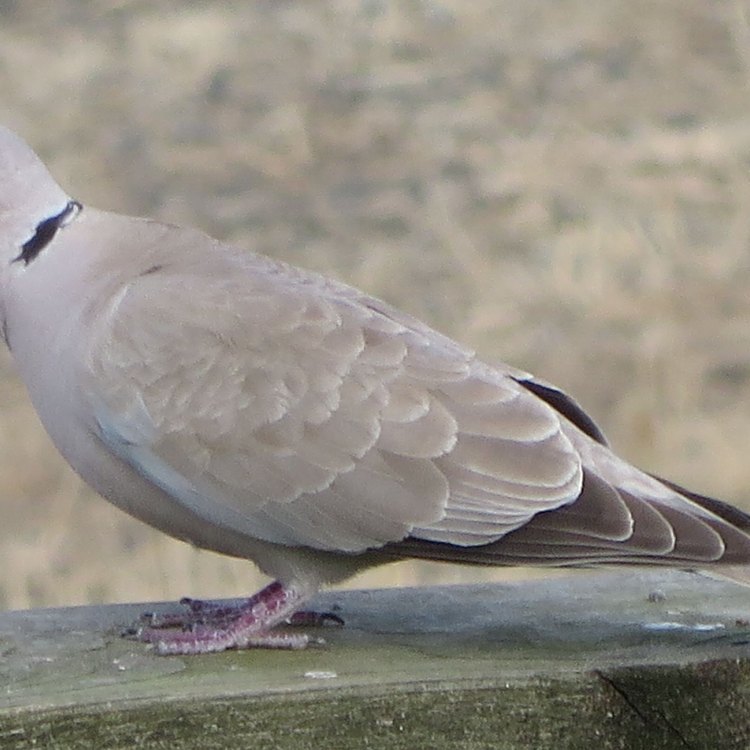
Eurasian Collared Dove
- Adult Size: Medium-sized bird
- Average Lifespan: 3-5 years
- Reproduction: Sexual
- Reproductive Behavior: Monogamous
- Sound or Call: Soft cooing sound
- Migration Pattern: Resident, non-migratory
- Social Groups: Solitary or in pairs
- Behavior: Peaceful and docile, often seen perched in trees or on utility wires
- Threats: Habitat loss, hunting
- Conservation Status: Least Concern
- Impact on Ecosystem: Competes with native bird species for resources
- Human Use: Hunted as game birds, kept as pets
- Distinctive Features: Black half-collar on the back of the neck
- Interesting Facts: Introduced to North America in the 1980s and rapidly expanded its range
- Predator: Birds of prey, domestic cats
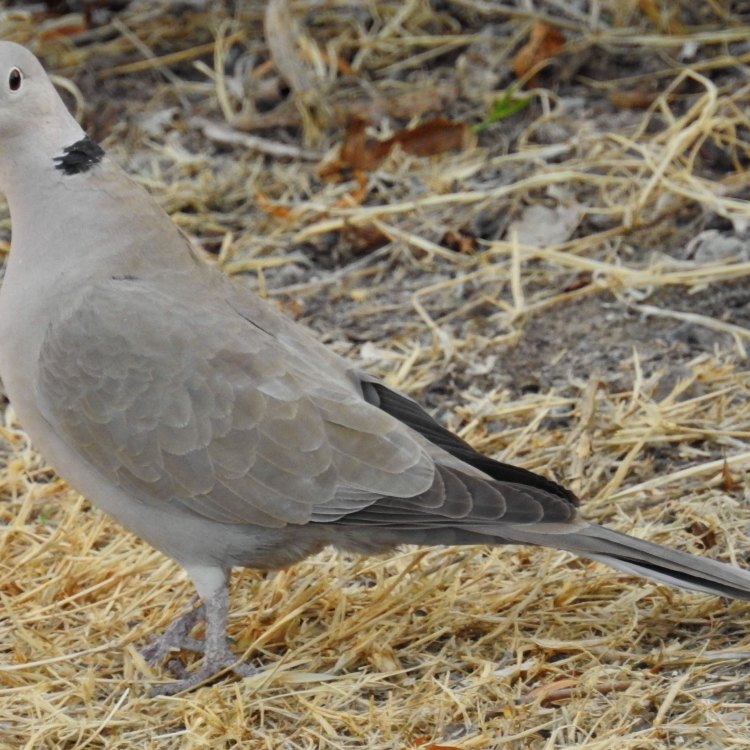
Streptopelia decaocto
Eurasian Collared Dove: The Peaceful Dove That Conquered North America
When we think of doves, we often imagine them as symbols of peace and love, gracefully fluttering around with their white feathers and gentle cooing. However, there is a particular dove species that has not only brought peace with its presence but also managed to conquer an entire continent – the Eurasian Collared Dove.From its distinctive features to its impact on the ecosystem, let us take a closer look at this remarkable bird and uncover the unique traits that helped it thrive in North America.
The Basics: Adult Size and Average Lifespan
The Eurasian Collared Dove is a medium-sized bird, measuring between 28-33 cm in length and weighing around 125-240 grams PeaceOfAnimals.Com. Its wingspan can reach up to 47-55 cm, making it slightly larger than the average dove species.In terms of lifespan, the Eurasian Collared Dove has an average lifespan of 3-5 years in the wild, with some individuals living up to 8 years. However, in captivity, they can live up to 12-20 years with proper care and nutrition.
Reproduction and Reproductive Behavior
Like most birds, the Eurasian Collared Dove has sexual reproduction. This means that a male and a female need to mate to produce offspring. Doves are monogamous, meaning they mate with only one partner for life. However, in some cases, a dove may find a new mate if its partner dies.The breeding season for the Eurasian Collared Dove varies depending on their location. In most parts of their range, breeding occurs from April to August Eagle. After mating, the female will lay 2 small white eggs, which both parents will take turns incubating for about 14-18 days. Once the eggs hatch, the parents will continue to care for their young for 13-19 days until they leave the nest.
Sound or Call: The Soft Cooing Sound
One of the most distinctive features of the Eurasian Collared Dove is its soft cooing sound. This gentle cooing, often described as a "three-note phrase," is usually used for communication and can be heard from both males and females.This dove's call is often incorporated into soundscapes, adding a serene and peaceful atmosphere to the surroundings. However, as peaceful as their sound may be, it plays a part in their survival as well. The soft cooing sound helps them attract a mate and defend their territory.
Migration Pattern and Social Groups
One of the most interesting aspects of the Eurasian Collared Dove is its migration pattern. Unlike most bird species, they are considered residents, which means they do not migrate to other locations during different seasons.However, they do have a non-migratory range, meaning they can expand their range within their established territory. This allows them to adapt to different environments and find new food sources.
In terms of social groups, Eurasian Collared Doves are usually solitary or found in pairs, which is not surprising considering their monogamous reproductive behavior. However, during the non-breeding season, they may gather in small flocks of up to 20 doves.
Behavior: Peaceful and Docile Creatures
As their soft cooing call suggests, Eurasian Collared Doves have a peaceful and docile nature. They are often seen perched on tree branches or utility wires, basking in the sun and grooming their feathers.Unlike many bird species, they are not very active, and their flight patterns are often described as slow and leisurely. This calm demeanor makes them a popular choice for bird enthusiasts, as they are easy to watch and study without causing any disturbance.
Threats and Conservation Status
Although Eurasian Collared Doves have a peaceful nature, they face various threats in their natural habitat. One of the biggest threats is habitat loss, as they are dependent on trees for nesting and roosting. This has become a significant issue due to deforestation and urbanization.Another threat they face is hunting, as they are often hunted as game birds in some areas. However, this is not a major issue as they are widespread and can be legally hunted in most regions.
Despite these threats, the Eurasian Collared Dove has a conservation status of Least Concern. This means that their populations are stable, and they are not facing any immediate risks of extinction. In fact, their numbers have been increasing over the years, mainly due to their successful introduction to North America.
Impact on the Ecosystem: Outcompeting Native Bird Species
The Eurasian Collared Dove's introduction to North America is a fascinating story. In the 1980s, a few individuals escaped from captivity and established themselves in Florida. From there, they rapidly expanded their range across the United States and Canada, and can now be found in almost every state and province.While this may seem like a success story, it has had a significant impact on the ecosystem. As an invasive species, they compete with native bird species for resources, such as nesting sites and food. This competition can lead to displacement and even local extinctions of some bird species.
In addition to outcompeting native bird species, the rapid increase in Eurasian Collared Dove populations has also affected farmers. These doves have a habit of feeding on crops, causing damage and loss to agriculture.
Human Use: Game Birds and Pets
Aside from being hunted as game birds in some parts of their range, Eurasian Collared Doves also have a fascinating history with human use. In the past, they were kept as pets, and their domesticated strain, the Ringneck Dove, is still popular today.In some cultures, doves are considered sacred and used in ceremonies and rituals. Their peaceful nature and soft cooing sound also make them a popular choice for wedding releases and other celebrations.
Distinctive Features: The Black Half-Collar
One of the most distinctive features of the Eurasian Collared Dove is the black half-collar on the back of its neck, which gives it its name. This half-collar is a patch of black feathers and is absent in juvenile doves.This unique feature sets it apart from other dove species, making it easy to identify. The rest of their plumage is mostly a light gray-brown color, with some white and black markings on their wings and tail.
Interesting Facts: Conquering North America and Predators
As mentioned earlier, the Eurasian Collared Dove was introduced to North America in the 1980s. However, what is even more surprising is how quickly they have expanded their range. In just a few decades, they have conquered an entire continent, making them one of the most successful invasive bird species.Even in their natural habitat, Eurasian Collared Doves face predators. Birds of prey, such as hawks and falcons, see them as a food source. Domestic cats are also known to hunt and kill doves, posing a threat to their populations.
In Conclusion
The Eurasian Collared Dove is a fascinating bird species that has brought peace and tranquility to North America, but at a cost. Its unique features, such as the black half-collar and soft cooing sound, make it stand out among other dove species.Despite facing threats and being labeled as an invasive species, the Eurasian Collared Dove has adapted and thrived in its new environment, leaving a mark on the ecosystem and human culture. Let us continue to appreciate and learn more about this peaceful dove and its remarkable journey.
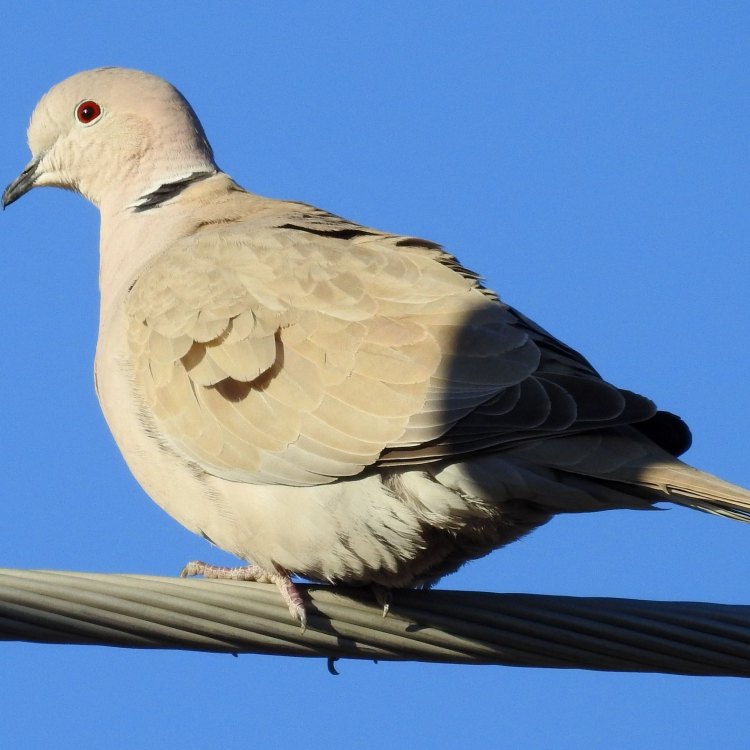
The Story of the Dainty and Adaptable Eurasian Collared Dove
Disclaimer: The content provided is for informational purposes only. We cannot guarantee the accuracy of the information on this page 100%. All information provided here may change without prior notice.

